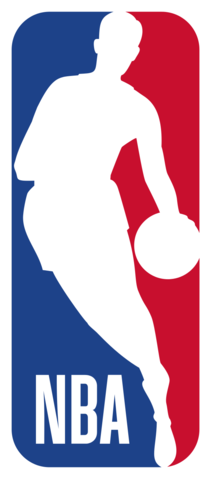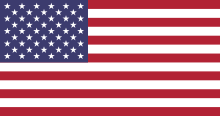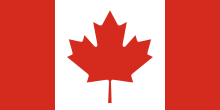| National Basketball Association | ||
|---|---|---|

| ||
| League information | ||
| Type | Professional basketball | |
| Country |  United States United States
| |
| Founded | June 6, 1946 | |
| Inaugural | 1946-47 sesason | |
| Key people |  Adam Silver (Commissioner) Adam Silver (Commissioner) Mark Tatum (Deputy Commissioner) Mark Tatum (Deputy Commissioner)
| |
| No. of teams | 30: 29 (  United States ) United States )1 (  Canada Canada
| |
| FIBA group | FIBA Americas | |
| Minor league | NBA Development League | |
| Playoffs | NBA Playoffs | |
| Championship information | ||
| Championship game |
NBA Finals | |
| Most recent | Cleveland Cavaliers (1st) | |
| Most Championships | Boston Celtics (17) | |
The National Basketball Association (NBA) is an American professional basketball league and one of the major professional sports leagues of North America.
The league was founded in New York, New York on June 6, 1946 as the Basketball Association of America (BAA). The league adopted the name National Basketball Association in the autumn of 1949 after merging with the rival National Basketball League. The league's several international and individual team offices are directed out its head offices located in the Olympic Tower at 645 Fifth Avenue in New York City. NBA Entertainment and NBA TV studios are directed out of offices located in Secaucus, New Jersey.
History
The Basketball Association of America was founded in 1946 by the owners of the major sports arenas in the Northeast and Midwest, most notably Madison Square Garden in New York City. Although there had been earlier attempts at professional basketball leagues, including the American Basketball League and the National Basketball League, the BAA was the first league to attempt to play primarily in large arenas in major cities. During its early years, though, the quality of play in the BAA was not obviously better than in competing leagues or among leading independent clubs such as the Harlem Globetrotters. For instance the 1947 ABL finalist Baltimore Bullets moved to the BAA and won its 1948 title, followed by the 1948 NBL champion Minneapolis Lakers who won the 1949 BAA title. On November 1, 1946, the Toronto Huskies hosted the New York Knickerbockers which the NBA now regards as its first game to be played in the league's history. Ossie Schectman scored the first basket of that game, which makes his basket the first in NBA history.
Following the 1949 season, the BAA agreed to merge with the NBL, expanding the National Basketball Association to seventeen franchises located in a mix of large and small cities, as well as large arenas and smaller gymnasiums and armories. In 1950, the NBA consolidated to eleven franchises, a process that continued until 1954, when the league reached its smallest size of eight franchises, all of which are still in the league (the Knickerbockers/Knicks, Celtics, Warriors, Lakers, Royals/Kings, Pistons, Hawks, and Nationals/76ers).
While contracting, the league also saw its smaller city franchises move to larger cities. The Hawks shifted from "Tri-Cities" (the area now known as the Quad Cities) to Milwaukee and then to St. Louis; the Royals from Rochester to Cincinnati, the Pistons from Fort Wayne, Indiana to Detroit.
Although Japanese-American Wataru Misaka technically broke the NBA color barrier in the 1947-48 season when he played for the New York Knicks, 1950 is recognized as the year the NBA integrated with the addition of African American players by several teams including Chuck Cooper with the Boston Celtics, Nat "Sweetwater" Clifton with the Knicks, and Earl Lloyd with the Washington Capitols. Today, more than fifty years later, the NBA is made up of players of many different races, with diverse backgrounds and cultures. The majority (80%) of NBA players today are African American.
During this period, the Minneapolis Lakers, led by center George Mikan, won five NBA Championships and established themselves as its first dynasty.
To liven up play, the league introduced the 24-second shot clock in 1954.
In 1956, rookie center Bill Russell joined the Boston Celtics, who already featured guard Bob Cousy and coach Red Auerbach, and went on to lead the club to eleven NBA titles in thirteen seasons. Center Wilt Chamberlain entered the league in 1959 and became the dominant individual star of the 1960s, setting new records in scoring and rebounding. Russell's rivalry with Chamberlain became one of the great individual rivalries in the history of team sports.
Through this period, the NBA continued to strengthen with the shift of the Minneapolis Lakers to Los Angeles, the Philadelphia Warriors to San Francisco, and the Syracuse Nationals to Philadelphia, as well as the addition of its first expansion franchises.
In 1967, the league faced a new external threat with the formation of the American Basketball Association. The leagues engaged in a bidding war for talent. The NBA landed the most important college star of the era, Kareem Abdul-Jabbar (then known as Lew Alcindor), who together with Oscar Robertson led the Milwaukee Bucks to a title in his second season, and who later played on five Laker championship teams.
However, the NBA's leading scorer, Rick Barry jumped to the ABA, as did four veteran referees—Norm Drucker, Earl Strom, John Vanak and Joe Gushue.
The ABA also succeeded in signing a number of major stars, including Julius Erving, in part because it allowed teams to sign college undergraduates. The NBA expanded rapidly during this period, one purpose being to tie up most viable cities. Following the 1976 season, the leagues reached a settlement that provided for the addition of four ABA franchises to the NBA, raising the number of franchises in the league at that time to 22.
The league added the ABA's innovative three-point field goal beginning in 1979 to open up the game. That same year, rookies Larry Bird and Magic Johnson joined the Boston Celtics and Los Angeles Lakers, respectively, initiating a period of significant growth in fan interest in the NBA throughout the country and the world. Bird went on to lead the Celtics to three titles, and Johnson went on to lead the Lakers to five.
Michael Jordan entered the league in 1984 with the Chicago Bulls, providing an even more popular star to support growing interest in the league. By 1989, further expansion had raised the number of teams in the league to 27. During the 1990s, Jordan went on to lead the Bulls to six titles. (1991-1993,1996-1998)
The 1990s also saw greater globalization. The 1992 Olympic basketball Dream Team, the first to use current NBA stars, featured Michael Jordan, Larry Bird, and Magic Johnson. A growing number of NBA star players also began coming from other countries. Initially, many of these players, such as 1994 NBA MVP Hakeem Olajuwon of Nigeria, first played NCAA basketball to enhance their skills. An increasing number, though, have moved directly from playing elsewhere in the world to starring in the NBA, such as 2002 NBA Rookie of the Year and 2006 World Championships MVP Pau Gasol of Spain, first pick in the 2002 NBA Draft Yao Ming of China, 2002 World Championships and Eurobasket 2005 MVP Dirk Nowitzki of Germany, and 2004 Olympic Tournament MVP Manu Ginobili of Argentina. Today, young players from the English-speaking world tend to attend U.S. colleges before playing in the NBA (notable examples are 2005 and 2006 MVP Steve Nash, a Canadian, and 2005 top draft pick Andrew Bogut of Australia), while other international players generally come to the NBA from professional club teams. The NBA is now televised in 212 nations in 42 languages.
In 1996 the NBA created a women's league, the Women's National Basketball Association, and in 2001 created an affiliated minor league, the National Basketball Development League, now called the NBA Development League.
In 1998 the NBA owners began a lockout which lasted 191-days and was settled on January 18, 1999. As a result of this lockout the 1998-99 NBA season was reduced from 82 to 50 games, which were all played in early 1999.
Today, the NBA has reached 30 franchises and continues to evolve as one of the premier sports leagues in the world.
Location of NBA teams, conferences and divisions
On June 29, 2006, a new official game ball was introduced for the 2006-07 season, marking the first change to the ball in over 35 years and only the second in 60 seasons. Manufactured by Spalding, the new ball features a new design and new synthetic material that Spalding claims offers a better grip, feel, and consistency than the original ball. However, many players have been vocal in their disdain for the new ball, saying that it is too sticky when dry, and too slippery when wet. The NBA has promised to do extensive testing of the new ball, but so far has shown no indication that it plans to return to the older leather ball. Also new in 2006, the NBA team jerseys will now be manufactured by Adidas after the company purchased Reebok, the previous uniform supplier.
Teams
The National Basketball Association originated in 1946 with 11 teams, and through a sequence of team expansions, reductions, and relocations currently consists of 30 teams, 29 of which are based in the United States and 1 in Canada. The Boston Celtics are the most successful franchise with 16 NBA Finals wins. The next most successful franchise is the Los Angeles Lakers, who hold 14 championships. The Golden State Warriors won the most recent championship, their fourth.
The current league organization divides the teams into two conferences. Each conference has three divisions, and each division has five teams. The current divisional alignment was introduced in the 2004-05 season.
Notes:
- An asterisk (*) denotes a franchise move. See the respective team articles for more information.
- The Fort Wayne Pistons, Minneapolis Lakers and Rochester Royals all joined the NBA (BAA) in 1948 from the NBL.
- The Syracuse Nationals and Tri-Cities Blackhawks joined the NBA in 1949 as part of the BAA-NBL merger.
- The Indiana Pacers, New York Nets, San Antonio Spurs, and Denver Nuggets all joined the NBA in 1976 as part of the NBA-ABA merger.
- Due to arena damage caused by Hurricane Katrina, the New Orleans Hornets played most of their 2005-06 and 2006-07 home schedules in Oklahoma City. They have since returned to New Orleans.
Defunct teams
Regular season
Template:Dab current Following the summer break, teams hold training camps in October. Training camps allow the coaching staff to evaluate players (especially rookies), scout the team's strengths and weaknesses, prepare the players for the rigorous regular season, and determine the 12-man active roster (and a 3-man inactive list, if needed) with which they will begin the regular season. Teams have the ability to assign players with less than two years of experience to the NBA development league. After training camp, a series of preseason exhibition games are held. The NBA regular season begins in the last week of October.
n the regular season, each team plays 82 games, which are divided evenly between home and away games. Schedules are not identical for all teams. A team faces opponents in its own division four times a year, teams from the other two divisions in its conference either three or four times, and teams in the other conference twice apiece. A team can therefore have a relatively easy or difficult schedule, depending on the division and conference it is located in. Following the recent changes to the National Hockey League's scheduling format, the NBA is now the only major league in North America in which all the teams play each other during the regular season, and where a season ticket holder can see every team in the league come to town in any one season.
[[Image:Bucks vs Bobcats - February 11th, 2006.jpg|thumb|left|Bucks playing the Bobcats.]
In February, the NBA regular season is interrupted to celebrate the annual NBA All-Star Game. Fans are balloted throughout the United States, Canada and through the internet, and the top vote-getters at each position in each conference are given a starting spot on their conference's All-Star team. Coaches vote to choose the remaining 14 All-Stars. Then, East faces West in the All-Star game. The player with the best performance during the game is rewarded with a Game MVP award. Other attractions of the All-Star break include the T-Mobile Rookie Challenge game, which pits the best rookies and the best second-year players against each other; the Foot Locker Three-Point Shootout, a competition between players to see who is the best three-point shooter; and the Sprite Rising Stars Slam Dunk contest, to see which player dunks the ball in the most entertaining way.
Shortly after the All-Star break is the league's trade deadline. After this date, teams are not allowed to exchange players with each other for the remainder of the season, although they may still sign and release players. Major trades are often completed right before the trading deadline, making that day a hectic time for general managers.
Around the end of April, the regular season ends. It is during this time that voting begins for individual awards, as well as the selection of the honorary league-wide postseason teams. The Sixth Man of the Year Award is given to the best player coming off the bench (not starting for his team). The Rookie of the Year Award is awarded to the most outstanding first-year player. The Most Improved Player Award is awarded to the player who is deemed to have shown the most improvement from the previous season. The Defensive Player of the Year Award is awarded to the league's best defender. The Coach of the Year Award is awarded to the coach that has made the most positive difference to a team. The Most Valuable Player Award is given to player deemed the most valuable for (his team) that season. Additionally, The Sporting News awards an unofficial (but widely recognized) Executive of the Year Award to the general manager who is adjudged to have performed the best job for the benefit of his franchise.
The postseason teams are the All-NBA Teams, the All-Defensive Teams, and the All-Rookie Teams; each consists of five players. There are three All-NBA teams, consisting of the top players at each position, with first-team status being most desirable. There are two All-Defensive teams, consisting of the top defenders at each position. There are also two All-Rookie teams, consisting of the top first-year players regardless of position.
Playoffs
see: NBA Playoffs
The NBA Playoffs always begin in late April, with eight teams in each conference qualifying for the playoffs. The top three seeds for each conference are determined by taking the winners of the conference's three divisions and ranking them by regular season record. The remaining five seeds are determined by taking the five teams with the next-best records from among the non-division winning teams in the conference. However, the seeding system has one feature that is unusual in North American sports; division champions do not necessarily have home-court advantage in the playoffs. Although the playoff brackets are not reseeded, home-court advantage is based strictly on regular-season record, without regard to whether a team won its division.
Having a higher seed offers several advantages. Since the first seed plays the eighth seed, the second seed plays the seventh seed, the third seed plays the sixth seed, and the fourth seed plays the fifth seed in the playoffs, having a higher seed generally means you will be facing a weaker team. The team in each series with the better record has home court advantage, including the First Round. This means that, for example, if the team who receives the 6 (six) seed has a better record than the team with the 3 (three) seed (seeded thus by virtue of a divisional championship), the 6 seed would have home court advantage, even though the other team has a higher seed. Therefore, the team with the best regular season record in the league is guaranteed home court advantage in every series it plays.
The playoffs follow a tournament format. Each team plays a rival in a best-of-seven series, with the first team to win four games advancing into the second round, while the other team is eliminated from the playoffs. In the next round, the successful team plays against another advancing team of the same conference. Thus, all but one team in each conference are eliminated from the playoffs. Since the NBA does not re-seed teams, the playoff bracket in each conference uses a traditional design, with the winner of the series matching the 1st and 8th seeded teams playing the winner of the series matching the 4th and 5th seeded teams, and the winner of the series matching the 2nd and 7th seeded teams playing the winner of the series matching the 3rd and 6th seeded teams. In every round of the NBA Playoffs, the best of seven series follows a 2-2-1-1-1 pattern, meaning that one team will have home court in games 1, 2, 5, and 7, while the other plays at home in games 3, 4, and 6. The final round (NBA Finals) followed a 2-3-2 pattern, meaning that one team will have home court in games 1, 2, 6, and 7, while the other plays at home in games 3-5, from the 1985 NBA Finals to the 2014 NBA Finals. The 2-3-2 format was chosen in 1985 to reduce the amount of cross-country travelling between the Boston Celtics and the Los Angeles Lakers who met frequently in the finals.
The final playoff round, a best-of-seven series between the victors of both conferences, is known as the NBA Finals, and it is held annually in June. The victor in the NBA Finals wins the Larry O'Brien Championship Trophy. Each player and major contributor, including coaches and the general manager, on the winning team receive a championship ring. In addition, the league awards an NBA Finals Most Valuable Player Award, which nearly always goes to a member of the winning team, though not by rule. There has been only one exception to date: Jerry West won the award in 1969 (the award's first season) even though his Los Angeles Lakers did not win the championship.
On August 2, 2006, the NBA announced the new playoff format. The new format takes the three division winners and the second-place team with the best record and rank them 1-4 by record. The other 4 slots are filled by best record other than those other 4 teams. This might be in relation to the 2006 playoffs when Dallas and San Antonio, the two best Western Conference Teams, faced each other in the semifinals. This new format ensures that the two best teams will not meet until the Conference finals.
Important people
Presidents and commissioners
- Maurice Podoloff, President from 1946 to 1963
- Walter Kennedy, President from 1963 to 1967 and Commissioner from 1967 to 1975
- Larry O'Brien, Commissioner from 1975 to 1984
- David Stern, Commissioner from 1984 to 2014
- Adam Silver, Commissioner 2014 to present
Players
Template:NBA50
Coaches
Rules named after a player
Awards
- NBA Most Valuable Player Award
- NBA Finals Most Valuable Player Award
- NBA Most Improved Player Award
- NBA Defensive Player of the Year Award
- NBA Sixth Man of the Year Award
- NBA Rookie of the Year Award
- NBA Coach of the Year Award
See also
- List of NBA Seasons
- NBA Development League (or NBA D-League)
- NBA Draft, NBA first overall draft pick
- National Basketball Association All-Star Game, NBA All Star Weekend
- NBA Playoffs, NBA Finals
- NBA dress code
- List of sports attendance figures - the NBA in a global context
- NBA Video Games
- NBA LIVE san antonio spurs vs memphis grizzlies
External links
- NBA.com
- National Basketball Players Association
- NBRA NBA Referees
- Time for the NBA to Hoop it Up -- Howard Bloom's Sports Business News.com
- As the NBA season begins – will pricing drive ticket sales? -- Howard Bloom's Sports Business News.com
| National Basketball Association | |||||||
|---|---|---|---|---|---|---|---|
| Comissioners | Maurice Podoloff (1946-1963) • Walter Kennedy (1963-1975) • Larry O'Brien (1975-1984) • David Stern (1984-2014) • Adam Silver (2014-present) | ||||||
| Teams | Atlanta Hawks • Boston Celtics • Brooklyn Nets • Charlotte Hornets • Chicago Bulls • Cleveland Cavaliers • Dallas Mavericks • Denver Nuggets • Detroit Pistons • Golden State Warriors • Houston Rockets • Indiana Pacers • Los Angeles Clippers • Los Angeles Lakers • Memphis Grizzlies • Miami Heat • Minnesota Timberwolves • Milwaukee Bucks • New Orleans Pelicans • New York Knicks • Oklahoma City Thunder • Orlando Magic • Philadelphia 76ers Phoenix Suns • Portland Trail Blazers • Sacramento Kings • San Antonio Spurs • Toronto Raptors • Utah Jazz • Washington Wizards | ||||||
| Affiliations | NBA Arenas • NBA G League • NBA Players Association | ||||||
| Media & Merchandise | NBA.com • NBA TV • NBA Store • NBA in Video games | ||||||
| Personnel | Players • Head Coaches • Owners | ||||||
| Annual events | Seasons • All-Star Game • Draft • Summer League • NBA Playoffs • NBA Finals | ||||||
| NBA Arenas | |||||||
|---|---|---|---|---|---|---|---|
| Arenas | State Farm Arena (Atlanta Hawks) • TD Garden (Boston Celtics) • Barclays Center (Brooklyn Nets)• Spectrum Center (Charlotte Hornets) • United Center (Chicago Bulls) • Rocket Mortgage FieldHouse (Cleveland Cavaliers) • American Airlines Center (Dallas Mavericks) • Pepsi Center (Denver Nuggets) • Little Caesars Arena (Detroit Pistons) • Chase Center (Golden State Warriors) • Toyota Center (Houston Rockets) • Bankers Life Fieldhouse (Indiana Pacers) • Staples Center (Los Angeles Clippers & Los Angeles Lakers) • FedEx Forum (Memphis Grizzlies) • American Airlines Arena (Miami Heat) • Target Center (Minnesota Timberwolves) • Fiserv Forum (Milwaukee Bucks) • Smoothie King Center (New Orleans Pelicans) • Madison Square Garden (New York Knicks) • Paycom Center (Oklahoma City Thunder) • Amway Center (Orlando Magic) • Wells Fargo Center (Philadelphia 76ers) • Footprint Center (Phoenix Suns) • Moda Center (Portland Trail Blazers) • Golden 1 Center (Sacramento Kings) • AT&T Center (San Antonio Spurs) • Scotiabank Arena (Toronto Raptors) • Vivint Arena (Utah Jazz) • Capital One Arena (Washington Wizards) | ||||||
| NBA seasons | |||||||
|---|---|---|---|---|---|---|---|
| 1940's | 1946-47• 1947-48 • 1948-49 • 1949-50 | ||||||
| 1950's | 1949-50 • 1950-51 • 1951-52 • 1952-53 • 1953-54 • 1954-55 • 1955-56 | ||||||
| 1960's | 1960–61 • 1961–62 • 1962–63 • 1963–64 • 1964–65 • 1965–66 • 1966–67 • 1967–68 • 1968–69 • 1969–70 | ||||||
| 1970's | 1970–71• 1971–72 • 1972–73 • 1973–74 • 1974–75 • 1975–76 • 1976–77 • 1977–78 • 1978–79 • 1979–80 | ||||||
| 1980's | 1980–81• 1981–82 • 1982–83 • 1983–84 • 1984–85 • 1985–86 • 1986–87 • 1987–88 • 1988–89 • 1989–90 | ||||||
| 1990's | 1990–91 • 1991–92 • 1992–93 • 1993–94 • 1994–95 • 1995–96 • 1996–97 • 1997–98 • 1998–99 • 1999-00 | ||||||
| 2000's | 2000–01 • 2001–02 • 2002–03 • 2003–04 • 2004–05 • 2005–06 • 2006–07 • 2007–08 • 2008–09 • 2009–10 | ||||||
| 2010's | 2010-11 • 2011-12 • 2012-13 • 2013-14 • 2014-15 • 2015-16 • 2016-17 • 2017-18 • 2018-19 • 2019-20 | ||||||
| 2020's | 2020-21 • 2021–22 • 2022–23 | ||||||
| This page uses Creative Commons Licensed content from Wikipedia (view authors). |
